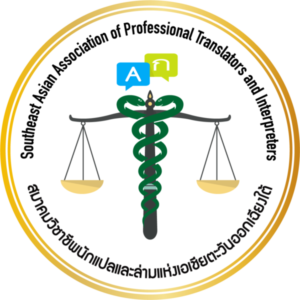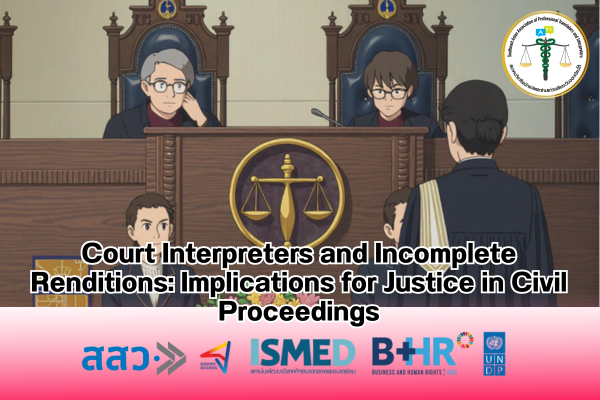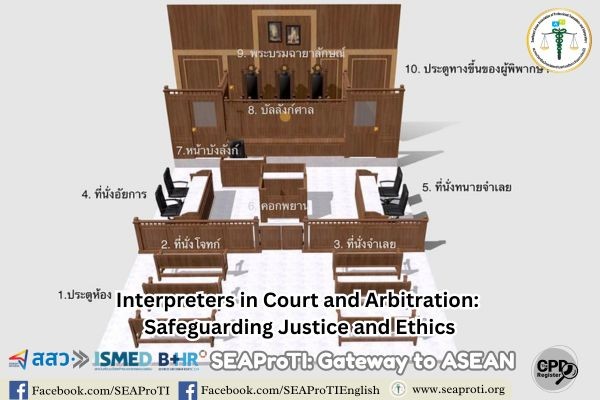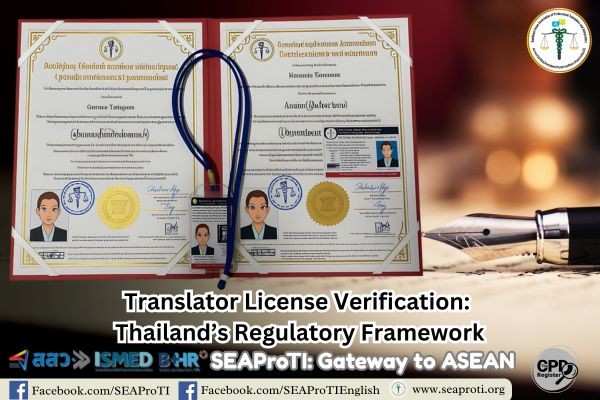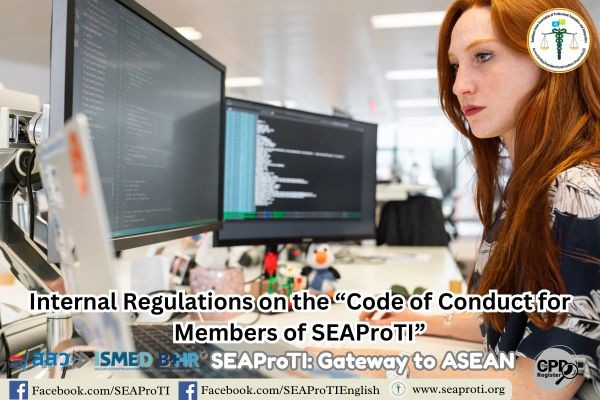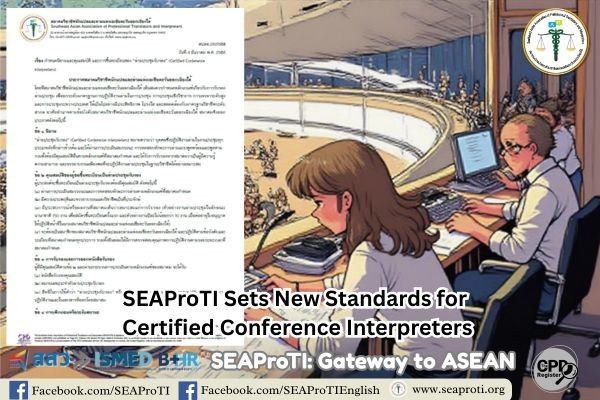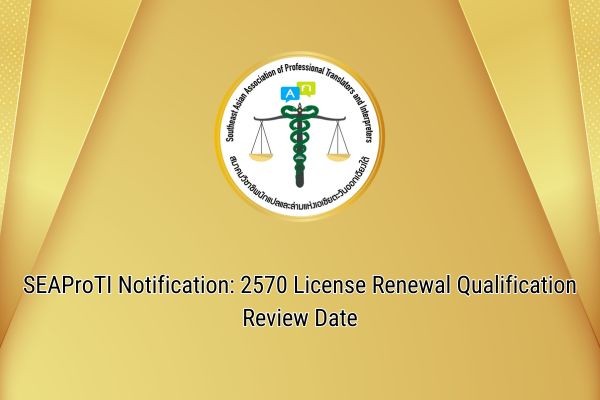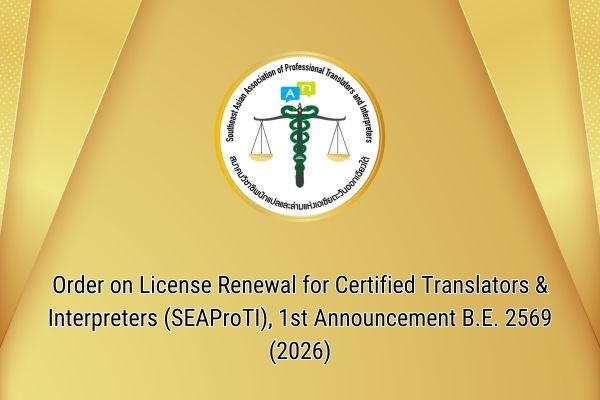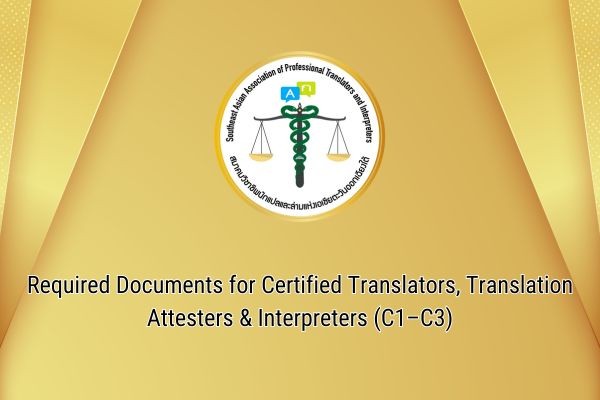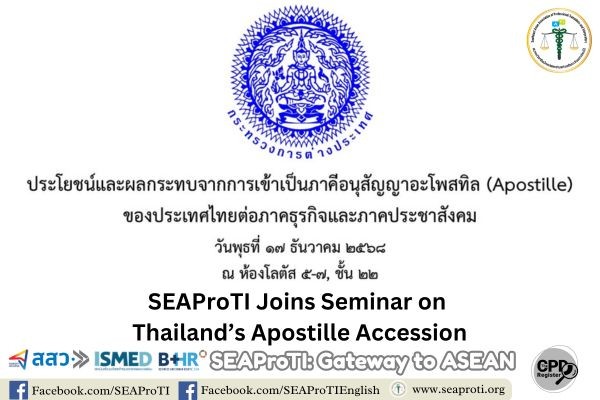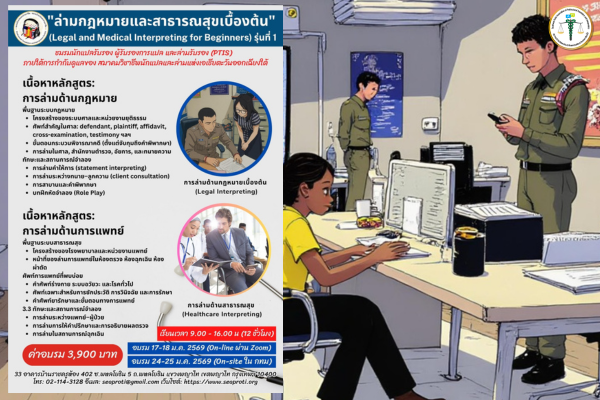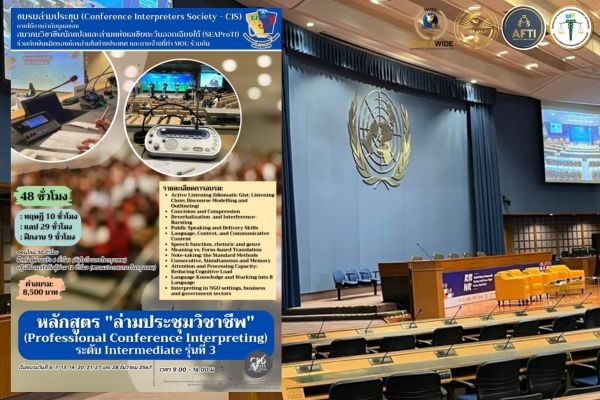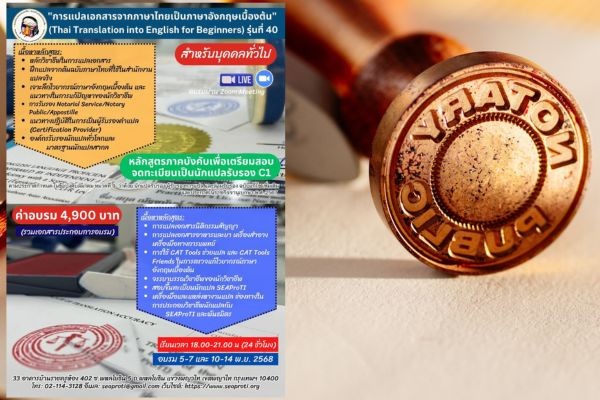Court Interpreters and Incomplete Renditions: Implications for Justice in Civil Proceedings
3 June 2025, Bangkok – This article examines a case in which a court interpreter rendered only 30–40% of a witness’s testimony, despite the witness speaking fully. Crucially, the omitted content would have benefitted one party, and the other party—who gained from the omission—did not object. The case reveals significant concerns about the qualifications of court interpreters, the misrepresentation of being “court-registered,” and the systemic impact of partial and biased interpretation. This paper analyzes the legal, ethical, and procedural ramifications and proposes structural reforms to enhance the quality and oversight of court interpreting in Thailand.
1. Introduction
In judicial proceedings, witness testimony is a core component of fact-finding. When a party or witness cannot communicate in Thai, interpreters serve as crucial conduits of information. They must interpret accurately, completely, and impartially. However, instances where interpreters provide only partial renditions pose serious threats to due process and the integrity of the trial.
2. Case Study: Interpreter Rendered Only 30–40% of Testimony
In the incident examined here, the interpreter conveyed merely 30–40% of the full testimony. Strikingly, the omitted segments were favorable to one party and went uncontested by that party, raising critical issues:
- Lack of Skill or Capacity: The interpreter may have lacked the linguistic or cognitive competence required for courtroom discourse, such as terminology management, note-taking, or real-time processing (Pöchhacker, 2004).
- Bias or Lack of Impartiality: Deliberately omitting content beneficial to the opposing party could amount to unethical conduct and a breach of neutrality (Gentile, Ozolins, & Vasilakakos, 1996).
- Misleading Claims of “Court Registration”: In Thailand, there is no formal or statutory “registration” of court interpreters. The phrase is often used to imply credibility without real evaluation or certification.
- Failure to Challenge by Opposing Party: Due to a lack of language proficiency, legal knowledge, or real-time awareness, the disadvantaged party may not object, resulting in undetected harm.
3. Legal and Ethical Implications
Incomplete or distorted interpretation in court has profound consequences:
- Violation of the Right to a Fair Trial: Protected under the Thai Constitution and Article 14 of the International Covenant on Civil and Political Rights (ICCPR), the right to fully understand and participate in proceedings is fundamental.
- Professional Misconduct: Interpreters who intentionally alter or omit meaning violate core tenets of professional ethics such as accuracy, impartiality, and accountability (NAJIT, 2006).
- Procedural Invalidity: If partial interpretation leads to an unjust verdict, it could justify an appeal or nullification of judgment (Office of the Council of State, 2019).
4. Policy Recommendations
- Establish Mandatory Interpreter Standards: Involve professional associations such as SEAProTI in certification and ethics enforcement.
- Legal and Judicial Interpreter Training: Court interpreters must be trained specifically in legal contexts, courtroom procedures, and legal terminology.
- Record All Interpreted Testimony: Audio or video recording should be required to enable retrospective verification of interpreting accuracy.
- Judicial Oversight: Courts should critically assess interpreter performance and allow for real-time objections and review mechanisms.
5. Conclusion
Even minor lapses in courtroom interpretation can lead to severe miscarriages of justice. This case underscores the need for a professionalized, accountable interpreter system within the Thai judiciary. Without oversight and reform, the right to a fair trial may remain illusory for those who rely on language access to participate in legal proceedings.
References
- Gentile, A. D., Ozolins, U., & Vasilakakos, M. (1996). Liaison Interpreting: A Handbook. Melbourne: Melbourne University Press.
- International Covenant on Civil and Political Rights. (1966). United Nations General Assembly. [Article 14].
- National Association of Judiciary Interpreters and Translators (NAJIT). (2006). Code of Ethics and Professional Responsibilities.
- Pöchhacker, F. (2004). Introducing Interpreting Studies. London: Routledge.
- Office of the Council of State. (2019). Guidelines on Interpreter Use in Judicial Proceedings. Bangkok: Office of the Judiciary.
SEAProTI’s certified translators, translation certification providers, and certified interpreters:
The Southeast Asian Association of Professional Translators and Interpreters (SEAProTI) has officially announced the criteria and qualifications for individuals to register as “Certified Translators,” “Translation Certification Providers,” and “Certified Interpreters” under the association’s regulations. These guidelines are detailed in Sections 9 and 10 of the Royal Thai Government Gazette, issued by the Secretariat of the Cabinet under the Office of the Prime Minister of the Kingdom of Thailand, dated July 25, 2024, Volume 141, Part 66 Ng, Page 100.
To read the full publication, visit: the Royal Thai Government Gazette
ล่ามในกระบวนการยุติธรรม: เมื่อคำแปลไม่ครบถ้วนและผลกระทบต่อความยุติธรรมในคดีแพ่ง
3 มิถุนายน 2568, กรุงเทพมหานคร – บทความนี้ศึกษากรณีการแปลถ้อยคำของพยานโดยล่ามในศาลที่แปลได้เพียงร้อยละ 30–40 ของถ้อยคำต้นฉบับ โดยเนื้อหาที่ละเว้นนั้นกลับเป็นประโยชน์แก่คู่ความฝ่ายหนึ่ง และไม่ได้รับการคัดค้านใด ๆ จากอีกฝ่ายหนึ่ง กรณีนี้สะท้อนปัญหาสำคัญเกี่ยวกับคุณสมบัติของล่ามในศาล ความเข้าใจผิดเกี่ยวกับการ “ขึ้นทะเบียนกับศาล” และผลกระทบทางกระบวนการยุติธรรมที่อาจเกิดขึ้นจากการแปลที่ไม่ถูกต้องและไม่เป็นกลาง บทความวิเคราะห์ผลกระทบทั้งด้านจริยธรรม กฎหมาย และสิทธิของคู่ความ พร้อมเสนอแนวทางปฏิรูปเพื่อยกระดับคุณภาพของการล่ามในศาล
1. บทนำ
ในกระบวนการยุติธรรม คำให้การของพยานถือเป็นหัวใจสำคัญของการพิจารณาคดี โดยเฉพาะในคดีที่มีคู่ความหรือพยานที่ไม่สามารถสื่อสารด้วยภาษาไทย ล่ามจึงมีบทบาทเป็นผู้ถ่ายทอดสารอย่างถูกต้อง ครบถ้วน และเป็นกลาง อย่างไรก็ดี ในหลายกรณีพบว่าล่ามไม่สามารถแปลสารของพยานได้อย่างครบถ้วน จนเกิดผลกระทบต่อผลแห่งคดีโดยตรง
2. กรณีศึกษา: ล่ามแปลเพียงบางส่วนของคำให้การ
ตัวอย่างกรณีที่ล่ามแปลคำให้การของพยานได้เพียงร้อยละ 30–40 ของถ้อยคำทั้งหมด ขณะที่ถ้อยคำที่ละเว้นกลับมี “น้ำหนัก” และ “ความเกี่ยวข้อง” กับข้อเท็จจริงในคดี และฝ่ายหนึ่งซึ่งได้ประโยชน์จากความไม่ครบถ้วนนั้นไม่มีการคัดค้านใด ๆ สะท้อนปัญหาหลายประการ ได้แก่:
- การขาดทักษะ: ล่ามอาจไม่มีความสามารถเพียงพอในการฟัง จด จำ และแปลคำให้การที่ยาวหรือซับซ้อน (Pöchhacker, 2004)
- ความไม่เป็นกลาง: หากการละเว้นเป็นไปโดยเจตนาเพื่อเอื้อผลประโยชน์แก่ฝ่ายใดฝ่ายหนึ่ง ย่อมขัดต่อหลักจริยธรรมวิชาชีพ (Gentile, Ozolins, & Vasilakakos, 1996)
- ความเข้าใจผิดของศาล: คำว่า “ล่ามขึ้นทะเบียนกับศาล” มักถูกอ้างเพื่อสร้างความเชื่อมั่น โดยไม่มีการประเมินผลการปฏิบัติงานจริง
3. ผลกระทบทางกฎหมายและจริยธรรม
การแปลไม่ครบถ้วนโดยล่ามในศาลอาจมีผลกระทบร้ายแรง ดังนี้:
- การละเมิดสิทธิในการพิจารณาคดีอย่างเป็นธรรม (right to fair trial) ซึ่งได้รับการรับรองในกฎหมายรัฐธรรมนูญและกติการะหว่างประเทศว่าด้วยสิทธิพลเมืองและสิทธิทางการเมือง (ICCPR, Article 14)
- การกระทำผิดจริยธรรมของล่าม หากพิสูจน์ได้ว่าล่ามจงใจละเว้นการแปลในลักษณะมีอคติ ย่อมขัดต่อหลักวิชาชีพ เช่น ความเป็นกลาง ความถูกต้อง และความรับผิดชอบ (NAJIT, 2006)
- กระบวนการพิจารณาอาจไม่ชอบด้วยกฎหมาย หากผลของคดีเปลี่ยนแปลงจากความบกพร่องของล่าม คู่ความอาจยื่นอุทธรณ์หรือขอเพิกถอนคำพิพากษาได้ (สำนักคณะกรรมการกฤษฎีกา, 2562)
4. แนวทางการปฏิรูป
- กำหนดมาตรฐานคุณสมบัติล่ามในศาล โดยให้องค์กรวิชาชีพเช่น SEAProTI มีบทบาทในการรับรองคุณสมบัติและจริยธรรม
- จัดอบรมล่ามด้านกฎหมายและศาลโดยเฉพาะ เพื่อให้เข้าใจหน้าที่ ความเสี่ยง และความรับผิดทางกฎหมาย
- ให้มีการบันทึกเสียง/วิดีโอในคดีที่มีล่าม เพื่อให้สามารถตรวจสอบความถูกต้องของการแปลย้อนหลังได้
- ศาลควรสอบทานการปฏิบัติหน้าที่ของล่ามมากขึ้น และเปิดโอกาสให้คู่ความสามารถนำล่ามมาเพื่อตรวจสอบและทักท้วงการแปลได้ในทันที
5. สรุป
การแปลคำให้การในศาลที่ไม่ครบถ้วนหรือมีอคติ แม้เพียงเล็กน้อย อาจส่งผลอย่างมีนัยสำคัญต่อความยุติธรรมในคดี กรณีศึกษาดังกล่าวชี้ให้เห็นถึงความจำเป็นในการยกระดับมาตรฐานคุณภาพของล่ามในกระบวนการยุติธรรม โดยต้องมีทั้งการกำกับดูแลด้านจริยธรรม การฝึกอบรมเฉพาะทาง และกลไกตรวจสอบย้อนหลังที่มีประสิทธิภาพ
บรรณานุกรม:
- Gentile, A. D., Ozolins, U., & Vasilakakos, M. (1996). Liaison Interpreting: A Handbook. Melbourne: Melbourne University Press.
- International Covenant on Civil and Political Rights. (1966). United Nations General Assembly. [Article 14].
- National Association of Judiciary Interpreters and Translators (NAJIT). (2006). Code of Ethics and Professional Responsibilities.
- Pöchhacker, F. (2004). Introducing Interpreting Studies. London: Routledge.
- สำนักคณะกรรมการกฤษฎีกา. (2562). แนวทางการใช้ล่ามในกระบวนการพิจารณาคดีในศาล. กรุงเทพมหานคร: สำนักงานศาลยุติธรรม.
เกี่ยวกับนักแปลรับรอง ผู้รับรองการแปล และล่ามรับรองของสมาคมวิชาชีพนักแปลและล่ามแห่งเอเชียตะวันออกเฉียงใต้
สมาคมวิชาชีพนักแปลและล่ามแห่งเอเชียตะวันออกเฉียงใต้ (SEAProTI) ได้ประกาศหลักเกณฑ์และคุณสมบัติผู้ที่ขึ้นทะเบียนเป็น “นักแปลรับรอง (Certified Translators) และผู้รับรองการแปล (Translation Certification Providers) และล่ามรับรอง (Certified Interpreters)” ของสมาคม หมวดที่ 9 และหมวดที่ 10 ในราชกิจจานุเบกษา ของสำนักเลขาธิการคณะรัฐมนตรี ในสำนักนายกรัฐมนตรี แห่งราชอาณาจักรไทย ลงวันที่ 25 ก.ค. 2567 เล่มที่ 141 ตอนที่ 66 ง หน้า 100 อ่านฉบับเต็มได้ที่: นักแปลรับรอง ผู้รับรองการแปล และล่ามรับรอง

